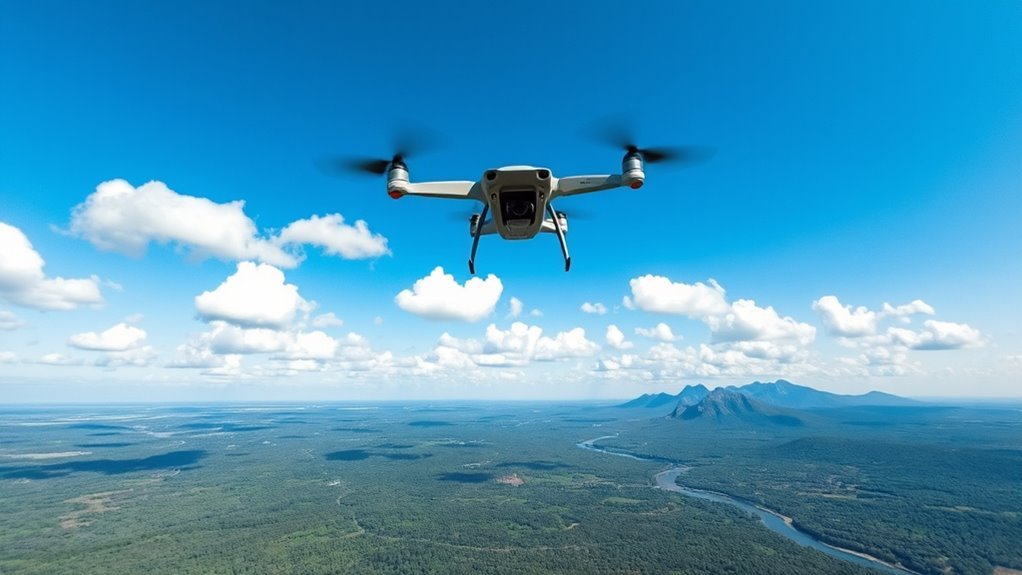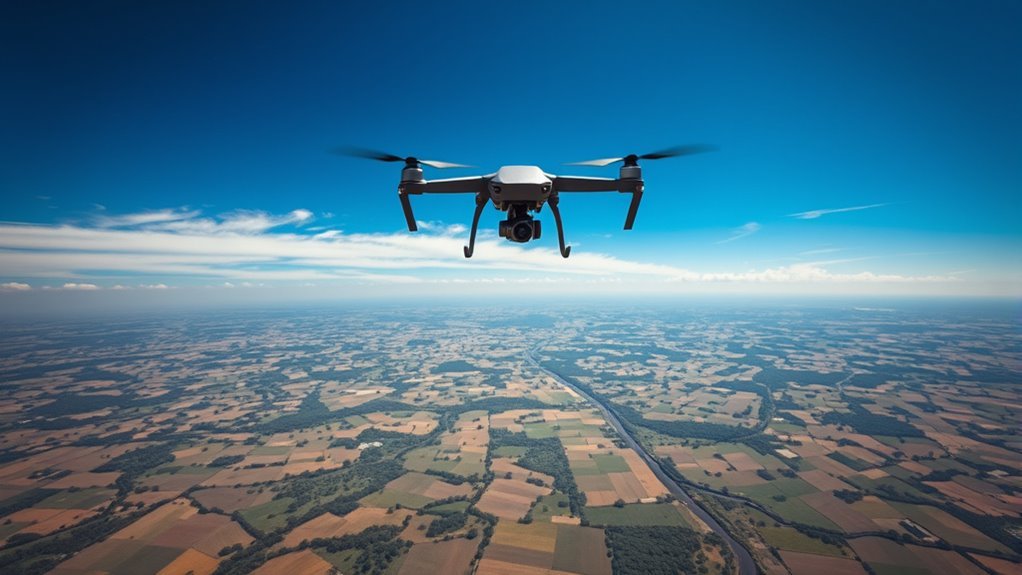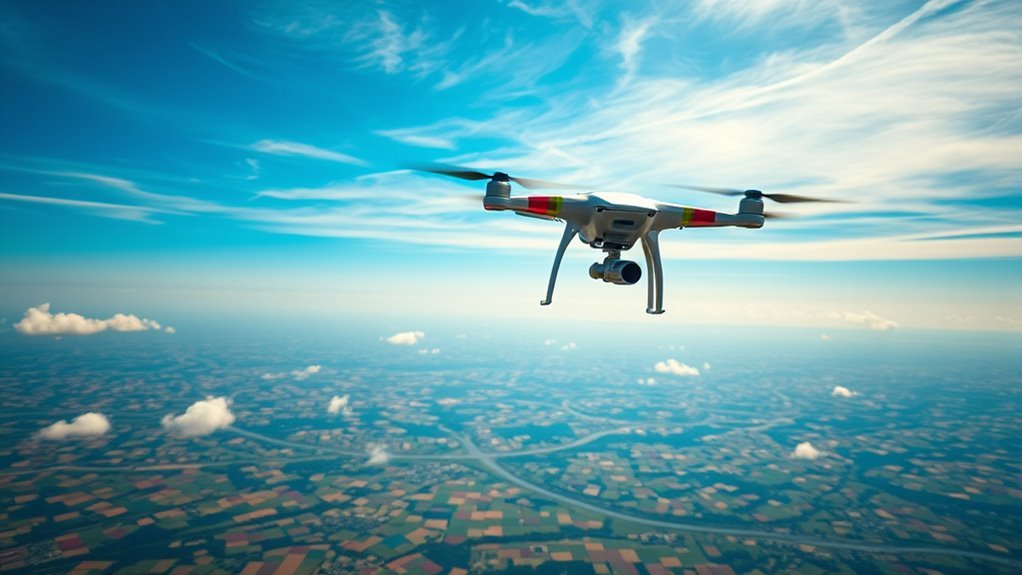Drones typically fly between 400 and 500 feet, but this range can vary based on design, weight, battery capacity, and regulatory guidelines. Factors like weather conditions and proper weight distribution also affect maximum altitude. Advanced technology, such as lightweight materials and sophisticated sensors, enhances altitude capability while maintaining safety. Understanding these influences is essential for effective drone operations. Explore the factors shaping drone altitude limits further to uncover insights for your aerial endeavors.
Understanding Drone Altitude Limits

How high can drones really fly? Drone altitude is primarily influenced by design, weight, and battery capacity. Generally, most consumer drones can reach altitudes between 400 and 500 feet, a limit established to guarantee flight safety and minimize risks to manned aircraft. Higher altitudes present challenges, including reduced battery life and increased exposure to wind and weather conditions. Understanding these limits empowers you to maximize your drone’s capabilities while adhering to safety practices. Additionally, flying at ideal heights allows for better data collection and aerial photography, enhancing your experience. Ultimately, knowing your drone’s altitude limits is essential for safe operation and achieving your aerial goals without compromising flight safety. Furthermore, battery life and power management are critical factors that dictate how high a drone can effectively fly without losing control. The DJI Mavic 3 Enterprise showcases superior battery technology, allowing it to maintain enhanced performance at higher altitudes compared to other models.
Regulatory Guidelines for Drone Flight

Maneuvering the regulatory landscape for drone flight is essential for operators to guarantee compliance and safety. Understanding the role of regulatory bodies, like the FAA in the U.S., is vital. They establish guidelines that dictate where and how high you can fly your drone, depending on airspace classifications. For instance, Class G airspace is generally unrestricted, allowing for more freedom, while Classes B, C, D, and E impose specific restrictions that you must adhere to. You’ll need to familiarize yourself with these classifications to avoid violations. Additionally, registering your drone and obtaining necessary waivers can further assure that your operations remain within legal parameters. Ultimately, staying informed on regulations empowers you to maximize your drone’s potential while maintaining safety.
Factors Affecting Drone Flight Height

While understanding regulatory guidelines is essential, several factors also influence how high you can fly your drone. Your drone’s battery performance directly impacts flight duration and altitude. A well-charged battery allows for higher flights, while a weak battery can limit your operational height. Additionally, weather conditions play a significant role; strong winds, rain, or extreme temperatures can compromise stability and safety. Proper weight distribution is crucial as it affects lift and can ultimately determine how high your drone can ascend. Drones with advanced battery technology can significantly enhance both flight time and altitude capabilities.
| Factor | Impact on Flight Height | Recommendations |
|---|---|---|
| Battery Performance | Determines max altitude | Verify battery is fully charged |
| Weather Conditions | Affects stability | Avoid flying in adverse weather |
| Weight of Payload | Influences lift | Minimize weight for higher flights |
Technological Advancements in Drone Capabilities
As drone technology evolves, enhancements in design and capabilities considerably expand operational flight heights. Advances in drone engineering facilitate the integration of lightweight materials and powerful propulsion systems, allowing for increased altitude potential. Modern drones utilize sophisticated altitude sensors that enable precise altitude control and real-time adjustments, enhancing stability at greater heights. These sensors, combined with advanced navigation systems, empower you to operate drones in diverse environments, overcoming atmospheric challenges. Additionally, AI enhances flight safety by providing real-time obstacle detection, which is crucial for high-altitude operations. Battery advancements also play a critical role, providing longer flight durations, which is essential for high-altitude missions. With these technological innovations, your operational scope broadens, granting you greater freedom to explore previously unreachable heights, ultimately transforming how drones are utilized across various industries. Additionally, the use of AI-driven choreography innovations enhances the ability of drones to perform complex maneuvers at altitude, pushing the boundaries of aerial displays.
Future Trends in High-Altitude Drone Operations
With the rapid evolution of drone technology, the future of high-altitude operations promises to be both innovative and transformative. You can expect high altitude applications to expand considerably, driven by advancements in battery life, aerodynamics, and AI navigation. These developments will enable drones to reach greater heights, enhancing their efficiency and operational range. One major trend is the integration of drone delivery systems, allowing for rapid transport of goods over long distances. As regulations evolve, you’ll find more opportunities for commercial and humanitarian missions. The push for sustainability will also lead to eco-friendly designs, minimizing environmental impact while maximizing utility. Moreover, the incorporation of advanced sensors will further enhance drone performance in various operational scenarios. Additionally, advancements in geofencing systems will ensure safer and more efficient operations in complex airspaces.
Frequently Asked Questions
What Types of Drones Can Fly at High Altitudes?
When considering high-altitude capabilities, you’ll find military drones generally excel due to advanced technology. In contrast, commercial drones, while limited, can still reach decent altitudes, depending on their design and intended use.
Can Weather Conditions Impact Drone Altitude?
You wouldn’t want your drone resembling a kite in a storm, right? Weather conditions considerably affect altitude. Temperature effects can alter lift, while wind resistance challenges stability, impacting your drone’s performance and operational freedom.
How Do Altitude Limits Vary by Country?
Altitude limits vary by country due to international regulations and specific altitude restrictions. You’ll need to research local laws to guarantee compliance, as these regulations can greatly impact your drone’s operational capabilities and flight freedom.
Are There Specific Drones for Extreme Altitude Flights?
Did you know some specialized drones can reach altitudes over 30,000 feet? For extreme altitude flights, these drones are engineered with advanced materials and technology, ensuring stability and performance in harsh atmospheric conditions.
What Are the Risks of Flying Drones at High Altitudes?
Flying drones at high altitudes poses risks like equipment failure and interference with manned aircraft. You must adhere to drone regulations and prioritize altitude safety to guarantee both your drone’s performance and the safety of others.

